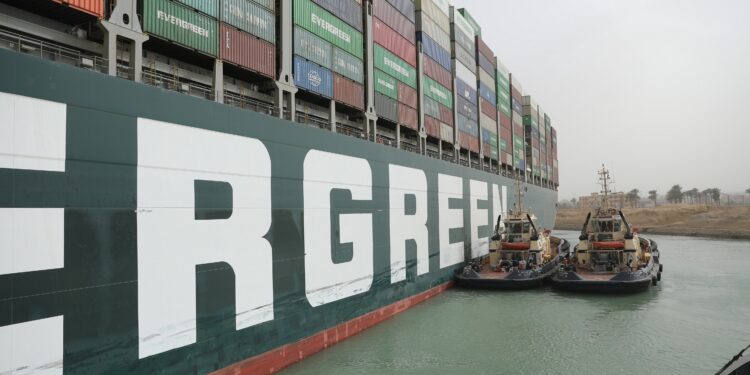Declaring “General Average” is a practice regularly seen after a maritime casualty, including the high-level Ever Given grounding in the Suez Canal that attracted significant attention, not only by industry people but also the wider public and made us wonder, what is it exactly about?
What does “General Average” mean?
General Average is a principle of maritime law that requires all sea cargo stakeholders -both the shipowner and the customers, like shippers- to evenly share any damage or losses that may occur as a result of voluntary sacrifice of part of the vessel or cargo to save the whole in an emergency. It is basically a voluntary sacrifice of “lesser” interest in rescue of a clearly “greater” one. In simpler terms, General Average means General Loss and signifies that the carrier is not responsible for the cargo loss, but every owner of cargo onboard is actually responsible, in part, for the cargo of others, as well as the ship itself.
When General Average is declared, cargo owners are required to contribute a deposit to a GA fund before their cargo can be released. If the cargo is insured, the insurance company provides this money and any contribution required for the loss. The GA terms are typically outlined in the bill of lading and can cover a long list of expenses, including towing and salvors.
Typical examples of GA
A typical case of a General Average sacrifice is throwing overboard (“jettison”) some cargo or ship’s material, equipment or stores, in order to lighten the ship amid a heavy storm. However, this does not occur often anymore. Today, the allocation of damages and costs in GA more often concerns extinguishing fire onboard or towing vessels suffering engine problems.
Why General Average?
As it becomes obvious, an emergency may leave little time for crew members to determine precisely whose cargo they are jettisoning. In order to avoid quarreling that could waste valuable time, there arose the equitable practice whereby all cargo owners who had their cargo landed safely would be called on to contribute a portion, based upon a share or percentage, to the ones whose goods had been thrown overboard.
The regulatory framework
The GA principle remains within the admiralty law of most countries. The regulatory basis of General Average can be traced to the York-Antwerp Rules of 1890, even though they have been updated several times since, with the latest updates in 2004 and 2016. These maritime rules outline the rights and obligations of both ship and cargo owners in the case that cargo must be jettisoned for the ship rescue. Under the rules, General Average clearly requires three conditions, all of which must be met for the rules to apply:
- The danger to the ship must be ‘imminent’ and apparently ‘inevitable’.
- There must be a voluntary jettison of some portion of the ship cargo for avoiding this peril.
- This attempt to avoid the imminent common peril must be successful.
The apportionment in GA is done by an average adjuster, a neutral third-party appointed by the shipowner, who determines the applicable costs owed to and by each stakeholder, which losses qualify for General Average, what are the total costs of the incident, as well as the amount each party owes, etc.
Famous GA cases
- Ever Given: Japanese Shoei Kisen Kaisha declared GA after the grounding of Ever Given, the mega container ship that blocked the entire Suez Canal for almost one week in March 2021 leaving more than 300 ships unable to transit the world’s busiest shipping route and sparkling an unprecedented trade disruption globally. Shortly after the ship was refloated, on 26 March, the owners declared GA. The ship size and the number of cargo owners involved means that this could be the largest ever general average case, adding to an already complex process, with experts estimating the procedure could take up to seven years.
- Ever Forward: Last March, the 12,000 TEU container ship Ever Forward ran aground in Chesapeake Bay and was refloated after over a month. On 31 March, Taiwanese shipping company Evergreen -also operator of the Ever Given- declared GA for the ship, claiming “increasing costs arising from the continued attempts to refloat it”.
- CMA CGM Libra: In May 2011, the Maltese-flagged container ship CMA CGM LIBRA ran aground off Xiamen, China, with 5,983 containers onboard. The shipowner declared General Average leading to about 92% of the cargo interests to be settled. However, about 8% refused to contribute voluntarily, claiming the shipowner’s fault in terms of errors in the ship’s passage plan and unseaworthiness before the commencement of the voyage. This triggered a lengthy debate across the industry as well as a court race regarding the conditions as to whether a vessel should be considered unseaworthy (Find more on the case here).
- Maersk Honam: In March 2018, the container ship Maersk Honam suffered a major fire onboard, leaving five crew members dead. After the incident, Maersk announced that berthing and discharging operations would result in high extraordinary costs and declared General Average. Eventually, shippers were able to pay to release their cargo within three months. Cargo owners aboard the Honam had to pay 54% of the cargo’s value to get it released, which was calculated as 42.5% of the cargo value for the security, plus 11.5% as deposit on the GA.
Did you know?
General average is not a modern-time technique, but it traces its origins in ancient maritime law. A form of what is now called general average was included in the Lex Rhodia, the Rhodes Maritime Code of circa 800 BC, while the Code of Hammurabi Law (around 1755–1750 BC) stipulated that a sea captain, ship-manager, or ship charterer that saved a ship from total loss was only required to pay one-half the value of the ship to the shipowner.








































































































































